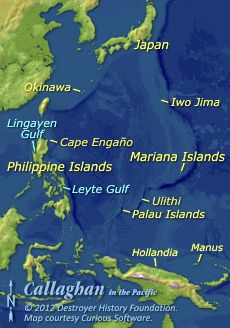The last American destroyer lost in World War II and the last Allied ship sunk in the Okinawa Gunto operation in July 1945 was one named for the task force commander killed at the
Naval Battle of Guadalcanal in 1942, USS
Callaghan (DD 792).
The seventh Fletcher-class 2,100-tonner built at Bethlehem Steel Co., San Pedro, California, Callaghan was laid down on 27 November 1943. At her launch on 1 August, she was sponsored by Mrs. Daniel J. Callaghan, widow of Rear Admiral Callaghan. She was placed in commissioned on 27 November under Commander F. J. Johnson and attached to Destroyer Division 109 of Destroyer Squadron 55 in the Pacific Fleet.
On 5 February 1944, Callaghan sailed from the West Coast to join Destroyer Division 110, Laws, Longshaw, Morrison and Prichett, in the screen of Admiral Raymond A. Spruance’s Fifth Fleet in strikes on the Palaus, Yap, Ulithi and Woleai from 30 March to 1 April.
In April, Callaghan and squadron flagship Porterfield operated from Manus as picket ships during air strikes and escorts for the fleet train in support of the General Douglas A. MacArthur’s Hollandia operation on New Guinea’s north coast.
Thereafter, Callaghan’s career was similar to those of Porterfield and her other sisters in DesDiv 109, Cassin Young, Irwin and Preston, also from Bethlehem, San Pedro.
- During Operation “Forager,” the Marianas operation from June to August 1944, the division less Preston plus Ross and Longshaw screened RAdm. Gerald F. Bogan’s Task Group 53.14—escort carriers Midway (CVE 63), White Plains (CVE 66), Kalinin Bay (CVE 68) and Fanshaw Bay (CVE 70)—which provided air support for the invasions of Saipan, Tinian and Guam. On 17 June at Saipan, Callaghan helped splash three enemy planes during a heavy Japanese air attack and thereafter retired to Eniwetok screening Fanshaw Bay, which had been struck by a bomb.
- For the invasion of the Palau Islands in late August, Callaghan began operations as escort for air strikes on the Palaus, Mindanao, Luzon and the Central Philippines.
- Attached to Admiral William F. Halsey, Jr.’s Third Fleet for General MacArthur’s return to the Philippines in October, Callaghan and her squadron operated with DesDiv 99 in RAdm. Frederick C. Sherman’s Task Group 38.3, screening Essex, Lexington, Princeton and Langley plus VAdm. Willis A. Lee’s battleships Washington, Massachusetts, South Dakota and Alabama and cruisers Santa Fe, Mobile, Birmingham and Reno in a drive north to neutralize Japanese airfields at Formosa and Okinawa. During a heavy enemy air attack on the 14th, she joined in downing several planes.
- For the Battle for Leyte Gulf on 24–25 October, Task Force 38 was stationed east of Luzon. Callaghan was not present for rescue operations with Cassin Young, Irwin, Morrison and cruiser Birmingham on the morning of the 24th when Princeton was hit by a kamikaze and sunk. Later in the day, however, aircraft from the other carriers in her task group participated in the attack on the Japanese Center Force in Sibuyan Sea. The following day, they attacked the Japanese Northern Force off Cape Engaño, after which Callaghan and her squadron were detached from their carriers to pursue remnants fleeing north.
- At the end of October, the task group returned to support Third Fleet air strikes on Luzon. When submarine I-41 torpedoed Reno on 3 November, Callaghan stood by until the cruiser could be taken under tow 1,500 miles back to Ulithi.
- In December, Callaghan’s task group conducted more air strikes on the Central Philippines, which it extended in January 1945 to Formosa, Luzon, Indochina, Hong Kong and the Ryukyu Islands and in February to Iwo Jima, Okinawa and the Tokyo area. Closing the Honshu coast on the morning of 18th, Porterfield and Callaghan sank a 100-ton picket boat with 40mm gunfire.
- On 3 March, Callaghan joined the bombardment of remote Parece Vela (Okinotori Island).
« « «
For Operation “Iceberg,” the invasion of Okinawa,
Callaghan and her squadron stood out from Ulithi and, on 26 March, commenced three months of fire support and screening duty. The Army declared Okinawa secure on 21 June but offshore radar picket stations were still active and on 9 July,
Callaghan was assigned to this duty.
Shortly after midnight on 28 July, as her crew looked forward to an imminent return home after 18 months at sea, Callaghan drove off a biplane intent on suicide but, unseen, the plane circled back. At 0041, it struck her on the starboard side near the No. 3 upper handling room while a bomb penetrated the after engine room. Fires soon began to detonate antiaircraft ammunition, which prevented nearby ships from closing to assist before Callaghan flooded by the stern and sank at 0235. One officer and 46 men were lost; two officers and 71 men were wounded.
Callaghan earned eight service stars during World War II.

